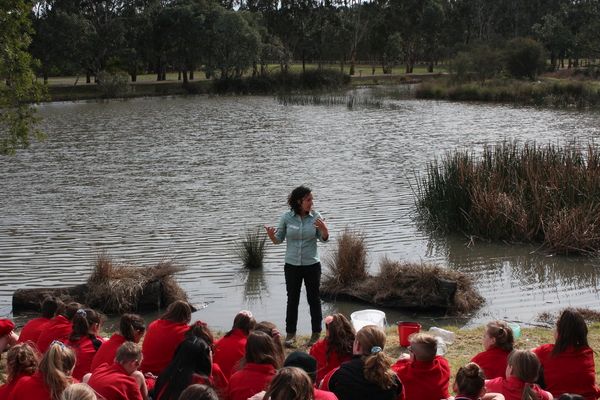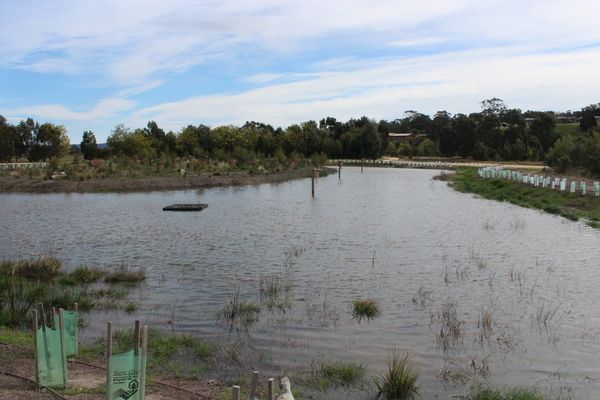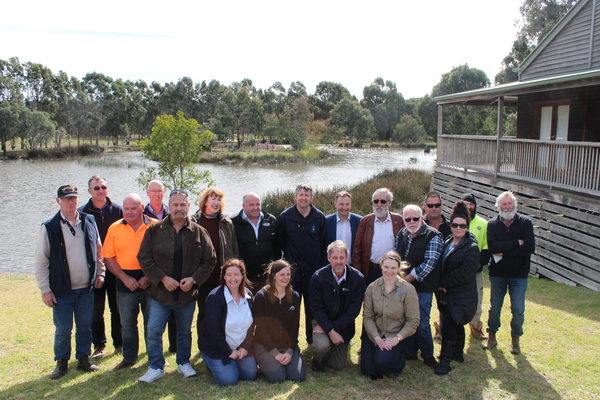It is amazing what a community can do!
In the small town of Heyfield, located about 200 kilometres east of Melbourne and with a population of just under 2,000 people, the community has come together to bring water for the environment to the Heyfield Wetlands for the first time.
Heyfield Wetland Committee supported strongly by the local community are currently working towards restoring the site back to a functioning wetland.
“The delivery of water for the environment at the site and the ongoing restoration demonstrates an extraordinary effort” said Heyfield Wetlands Committee member Barry Donahoe.
“We’ve put in two significant ponds and built waterways with the idea of expanding the aquatic habitat for birds and animals. We’ve planted thousands and thousands of trees and shrubs to achieve this and the water coming in is just putting the icing on the cake for us.”
In August an event was held to celebrate the hard work of everyone involved in bringing water for the environment to the wetlands.
“The Heyfield Wetlands are symbolic of a community effort,” said West Gippsland CMA Chief Executive Officer Martin Fuller.
“These wetlands tell a story of what has happened at this site over time, the community can identify with the wetlands remembering how they used the site. When I come here, I am immediately dragged back about 15 years to bike riding with family and friends, and now today we can see Heyfield Primary School students using the site as part of their education,” said Martin
“The ability to get some water here during this dry time is particularly important. This site demonstrates how important the wetlands and rivers are here with communities.”
The Heyfield Wetlands provides a space for locals and visitors to be outside and connect with nature. People enjoy walking along the wetland path and birdwatching at the site. It is hoped that the delivery of water for the environment will help enhance these values and continue to provide shared benefits for the broader community by boosting tourism and visitation to the area.

West Gippsland CMA’s Caitlin Pilkington running a session on water for the environment with Heyfield Primary School students, by VEWH
Getting water to the site is hard work!
Heyfield Wetlands was once a deep freshwater marsh that was periodically filled by the Thomson River. Following European settlement river flows were altered - dams were created, weirs were built, and levees were constructed and gradually the flows and water at the site were reduced.
“Evidence based decision making, utilising local knowledge together with river and wetland studies help inform us where water for the environment should be prioritised to get the best ecological benefits we can under prevailing conditions,” explained VEWH Commissioner Jennifer Fraser.
“This initiative is a great demonstration of a strong partnership between the Heyfield Wetlands Committee, West Gippsland Catchment Management Authority (CMA) and the Victorian Environmental Water Holder (VEWH) along with the support from Southern Rural Water and Gippsland Water to make a watering event happen.”
“The VEWH is supportive of watering the Heyfield Wetlands because it is one of the few remaining freshwater marshes present in the Gippsland Plains landscape, and so it is likely to provide an important refuge for aquatic animals and waterbirds, including several migratory species recorded by the Heyfield community,” said Jennifer.
West Gippsland CMA and Heyfield Wetland Committee worked together to coordinate the delivery of water. Using local knowledge together with environmental knowledge helps ensure that water for the environment can target ecological values and benefit the community.
The 10 megalitres of water for the environment is part of the VEWHs environmental entitlement for the Thomson River. It was extracted from the river with support from Gippsland Water and delivered through a 430-meter-long pipe to the wetlands.

Heyfield Wetlands during environmental watering, by VEWH
The work does not stop now!
The Heyfield Wetlands serve as a refuge for wetland and migratory animal species. This site is especially important as freshwater wetlands in the region diminish, due to impacts such as increasing salinity in the Gippsland Lakes.
To help understand the effectiveness of water for the environment at a site like the Heyfield Wetlands extensive monitoring is undertaken.
Four types of monitoring are currently underway:
- West Gippsland CMA is conducting water quality monitoring, which will help determine the impact of the watering on the health of the wetlands
- West Gippsland CMA has set up audio recording equipment to monitor the presence and species of frogs in the area before and after the delivery of water for the environment. Heyfield Wetlands could provide habitat for vulnerable species such as Growling Grass frog and the Green & Golden Bell frog which are present in the landscape.
- Heyfield Wetlands Committee supported by volunteers conduct regular bird counts at the site. Previously 92 different bird species have been recorded, including the threatened great egret, little black and little pied cormorants and eastern spoonbills. This year, counts are being taken after the watering event and preliminary results have shown more water birds visiting the area in response to the watering.
- Photo point monitoring by West Gippsland CMA is aiming to visually record the growth of water plants at the site and capture water levels as they recede.

Community and program partners on site at Heyfield Wetlands celebrating the first delivery of water for the environment, by VEWH